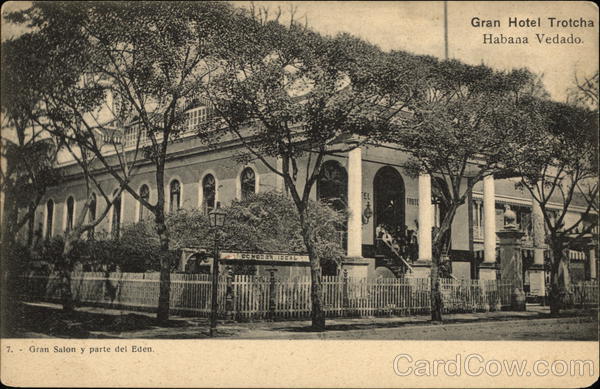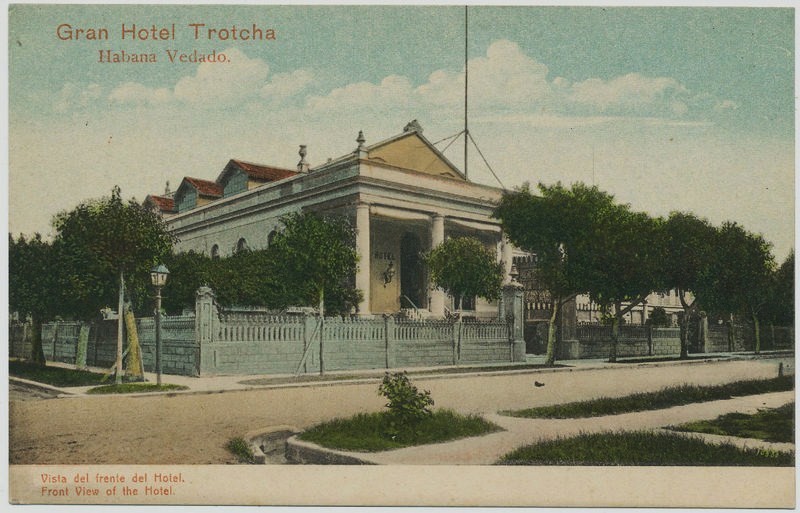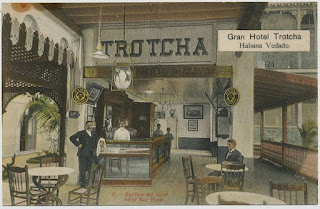 UN ‘JARDÍN DEL EDÉN’ CONVERTIDO EN RUINAS: EL HABANERO HOTEL TROTCHA.
UN ‘JARDÍN DEL EDÉN’ CONVERTIDO EN RUINAS: EL HABANERO HOTEL TROTCHA.
Los vientos que anunciaban la cercanía del huracán Irma terminaron por llevarse lo poco que quedaba ya del hotel Trotcha, en el Vedado. Testigos referirían que vieron cómo se tambaleaba la precaria columnata clasicista de la fachada del establecimiento que, en medio de un estruendo angustioso, no demoró en venirse abajo, y llegar con sus cascotes a la acera de enfrente.
Todavía en las guías turísticas de La Habana correspondientes a los años 50 del siglo pasado, aparecía consignado el hotel Trotcha, en Calzada, esquina a 2. Más acá en el tiempo, desapareció la parte de la instalación que daba servicio de alojamiento y subsistió el local del llamado salón, convertido ya en cuartería. A mediados de la década de 1990, o un poco antes, un incendio reducía a cenizas aquella triste casa de vecindad y dejaba invictas las columnas de la fachada que desaparecieron ahora con los embates del Irma.
En enero de 1890, apenas nueve meses antes de su fallecimiento, el poeta Julián del Casal, luego de un paseo por el «simpático caserío del Vedado», reseñó el Trotcha en una de sus crónicas, y dijo que estaba montado a la altura de «los mejores hoteles de Europa». Renée Méndez Capote lo evoca en sus ‘Memorias de una cubanita’ que nació con el siglo como un sitio que atraía a los niños por su criadero de cocodrilos y a las damas por sus jardines, donde sobresalían hortensias, dalias, nomeolvides, ixoras, gardenias, violetas… Más acá en el tiempo, Sergio, el personaje de ‘Memorias del subdesarrollo’, la famosa película de Tomás Gutiérrez Alea, desde su apartamento en el edificio Naroca, de Línea y Paseo, visualiza el hotel con un catalejo y recuerda que sus abuelos pasaron allí su luna de miel.
Bonaventura Trotcha y Formaguera fue el fundador del hotel que llevó su nombre. Nació en Arenys de Mar, Cataluña, y murió en La Habana el 4 de mayo de 1910, luego de unos 70 años de permanencia en la Isla. Fue un enamorado del Vedado; el hombre que posibilitó que el agua del acueducto de Albear llegara a la barriada.
Hasta 1895 hubo un desarrollo notable en el caserío del hoy Vedado. La cercanía del mar hizo que el barrio cobrara relevancia. En la línea de la costa, desde G hasta 6, se establecieron, a partir de 1864, varios balnearios. La calle E fue conocida popularmente con el nombre de Baños, porque llevaba a las pocetas del balneario El Progreso. Muy cerca del Trotcha, en lo que hoy sería Malecón y Paseo, estaban los baños de Carneado.
Abrió el salón Trotcha sus puertas en 1883, y ya en 1890, cuando lo visita Casal, se le había adicionado el área hotelera.
Se traspasaba la verja de hierro cuyas hojas se mantenían permanentemente abiertas y el visitante accedía al jardín del hotel Trotcha. Era el llamado Jardín del Edén por hallarse ubicado junto al área así denominada del establecimiento. En los ángulos del jardín se encontraban cuatro glorietas espaciosas bajo cuya sombra descansaban los huéspedes y saboreaban sus bebidas predilectas.
El área destinada a alojamiento era de madera. El salón se componía de dos pisos. En el primero, al nivel del jardín, se hallaba el restaurante, un largo salón, rodeado de refinados gabinetes. Allí se daban cita, en los días festivos, numerosas familias habaneras, pertenecientes a las más altas clases sociales.
Apuntaba Julián del Casal en su crónica: «Todo parece que convida a satisfacer las más imperiosas de las necesidades humanas. Las mesas elegantes, cubiertas de blancos manteles; los platos de fina porcelana, fileteados de rayas doradas; los manjares exquisitos, servidos en fuentes de plata; la profusión de licores, suficiente para todos los caprichos; y la finura de los dueños que se desviven por complacer a sus favorecedores hacen que este lugar sea el escogido por las personas de gustos refinados».
Se dejaba atrás el restaurante y se ascendía por una ancha escalinata de mármol, rodeada de una baranda verde. Franqueado el dintel, se entraba a un salón ornado de muebles labrados, espejos venecianos, alfombras suntuosas, jarrones japoneses y mesas cubiertas de bibelots. «Este salón tiene la apariencia de un parloir inglés», comentaba Casal. Seguían las habitaciones de los huéspedes, lujosamente decoradas.
«Todo pasó cuando ya fue pasado», exclama José Lezama Lima en uno de sus más célebres poemas.
Ya no queda nada de aquel hotel. Ni siquiera su columnata clásica que desafiaba al tiempo en una esquina privilegiada de La Habana hasta que se la llevaron los vientos del huracán Irma. Seguirá vivo en el imaginario de los habaneros que preferimos el esplendor de unas ruinas al mal gusto constructivo de los nuevos ricos.
A ‘EDEN GARDEN’ CONVERTED IN RUINS: THE HABANERO HOTEL TROTCHA.The winds that announced the proximity of Hurricane Irma ended up taking away what little was left of the Hotel Trotcha, in Vedado. Witnesses would say that they saw how the precarious classicist colonnade of the façade of the establishment teetered, that, in the midst of an anguished roar, did not take long to come down, and arrive with their rubble on the opposite sidewalk.
Still in the tourist guides of Havana corresponding to the 50s of the last century, the hotel Trotcha appeared in Calzada, corner 2. Most of the time, the part of the installation that provided the lodging service disappeared and subsisted the local of the called hall, already turned into cuartería. In the mid-1990s, or a little earlier, a fire reduced that sad tenement house to ashes and left the columns of the façade untouched, which now disappeared with the ravages of the Irma.
In January 1890, just nine months before his death, the poet Julián del Casal, after a walk through the “nice village of Vedado”, reviewed the Trotcha in one of his chronicles, and said he was mounted at the height of «The best hotels in Europe». Renée Méndez Capote evokes it in her ‘Memoirs of a cubanita’ that was born with the century as a place that attracted children for its crocodile farm and the ladies for its gardens, where hortensias, dahlias, forget-me-nots, ixoras, gardenias, violetas … More here in time, Sergio, the character of ‘Memorias del subdesarrollo’, the famous film by Tomás Gutiérrez Alea, from his apartment in the Naroca building, Line and Walk, visualize the hotel with a telescope and remember that his Grandparents spent their honeymoon there.
Bonaventura Trotcha y Formaguera was the founder of the hotel that bears his name. He was born in Arenys de Mar, Catalonia, and died in Havana on May 4, 1910, after some 70 years of permanence on the island. He was a lover of Vedado; the man who made it possible for the water of the aqueduct of Albear to reach the neighborhood.
Until 1895 there was a remarkable development in the village of today Vedado. The proximity of the sea made the neighborhood relevant. On the coastline, from G to 6, several spas were established from 1864 onwards. E Street was popularly known as Baños, because it led to the pocetas of the El Progreso spa. Very close to the Trotcha, in what today would be Malecón and Paseo, were the Carneado baths.
The Trotcha room opened its doors in 1883, and already in 1890, when Casal visited it, the hotel area had been added to it.
The iron gate was crossed, the leaves kept permanently open, and the visitor entered the garden of the Hotel Trotcha. It was called the Garden of Eden because it was located next to the so-called area of the establishment. In the angles of the garden were four spacious gazebos under whose shadow the guests rested and savored their favorite drinks.
The area intended for accommodation was made of wood. The living room consisted of two floors. In the first, at the level of the garden, was the restaurant, a long hall, surrounded by refined cabinets. There were gathered, on the holidays, numerous Havana families, belonging to the highest social classes.
Julian del Casal pointed out in his chronicle: “Everything seems to invite to satisfy the most imperative of human needs. The elegant tables, covered with white tablecloths; the plates of fine porcelain, fillets of golden stripes; the exquisite delicacies, served in silver fountains; the profusion of liquors, enough for all the whims; and the finesse of the owners who go out of their way to please their supporters make this place chosen by people with refined tastes “.
The restaurant was left behind and climbed up a wide marble staircase, surrounded by a green railing. Once the lintel was crossed, one entered a room decorated with carved furniture, Venetian mirrors, sumptuous carpets, Japanese vases and tables covered with bibelots. “This room has the appearance of an English parloir,” commented Casal. They followed the rooms of the guests, luxuriously decorated.
«Everything happened when it was already past», exclaims José Lezama Lima in one of his most famous poems.
There is nothing left of that hotel. Not even his classic colonnade that challenged time in a privileged corner of Havana until the winds of Hurricane Irma. He will continue to live in the imagination of the people of Havana who prefer the splendor of ruins to the constructive bad taste of the new rich.
Agencies/ Lecturas/ Ciro Bianchi/ Extractos/ Internet Photos/ Arnoldo Varona/ www.TheCubanHistory.com
THE CUBAN HISTORY, HOLLYWOOD.










